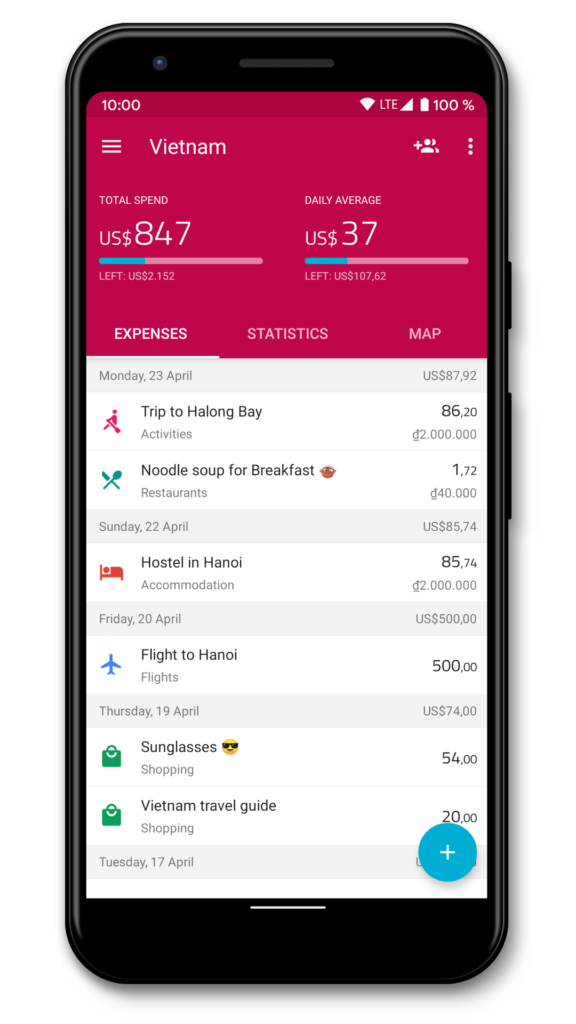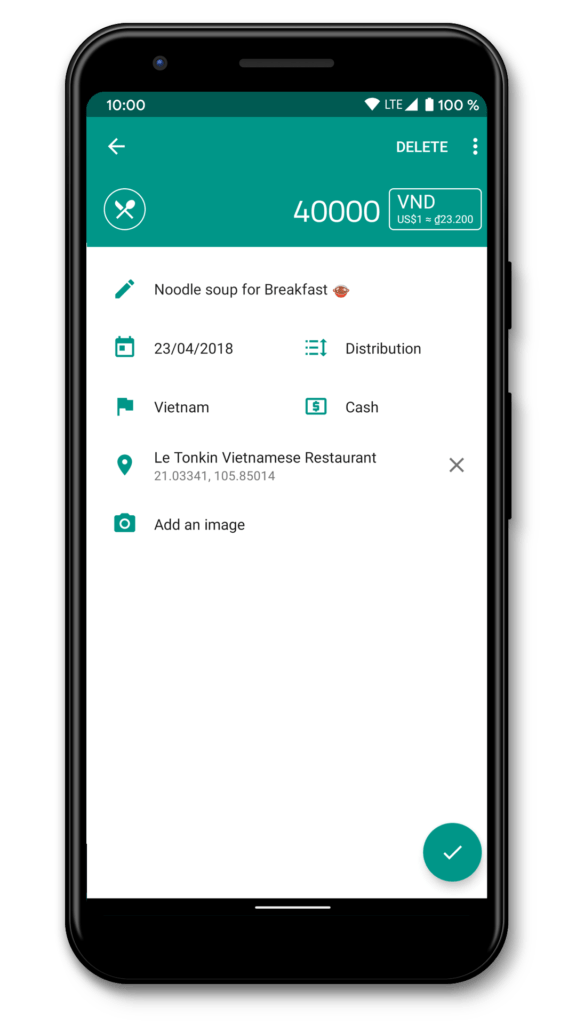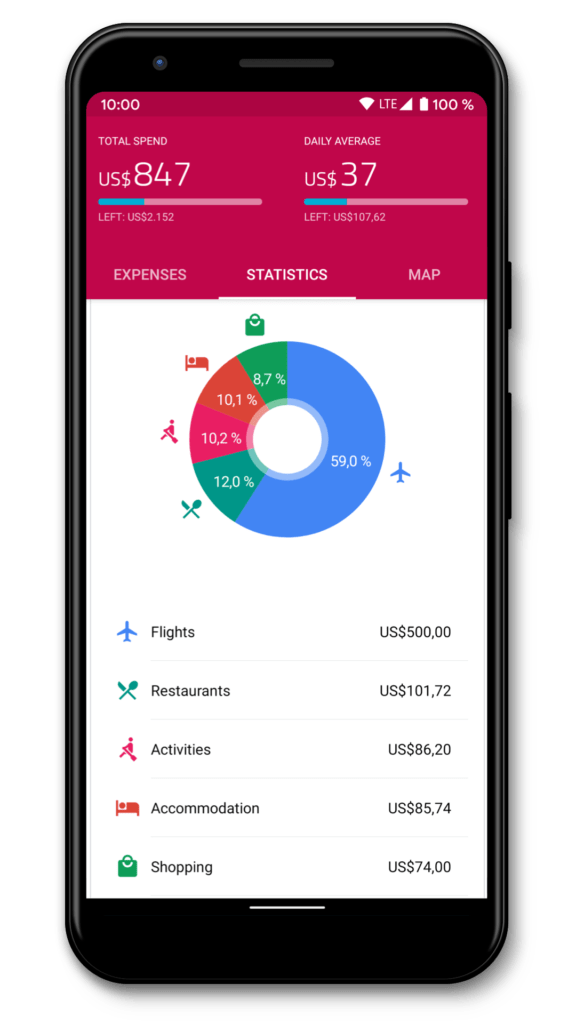Step four: estimate costs
One of the biggest questions is how much it costs to travel around the world. This part of planning a world trip was the biggest thing that was holding me back. Because well… a world trip isn’t cheap, but what most people don’t know is that it’s not that expensive either. It took some research to make a good estimated budget. To help you out I’ll share my research and preparations with you. To see how much the actual costs of my world trip is, you’ll need to wait at least two years to find out. In two years I’ll be back from my world trip and then I’ll have all the numbers that, of course, I’ll share with you
The importance of planning realistically
Depending on the planning of your world trip I can give you this: you’ll need at least € 10.000 to travel around the world. While traveling long-term isn’t free, I read on a lot of blogs that it’s also not as much as people think. There are people out there right now spending upwards of € 8000,- on a one-week trip to the Caribbean, and there are also people who have travelled for a year on that much.
Just as with planning where to go and for how long, there are a lot of factors that influence how much you’ll spend. There’s a difference in which countries you visit, the types of accommodation you stay in, how often you move between cities, your mode of transportation, and how many tours and activities you do. In this article I’ll explain which types of cost come into play associated with traveling around the world. Hopefully this can help you to make an estimated budget for your world trip.
But first! When you’re figuring out what your budget is, it’s important to be realistic and honest with yourself when answering the following questions:
- How many continents do you want to visit? - the more you go to, the more expensive it will be
- How fast do you want to go? - Faster = more money; slower = lower costs
- Are you fine with taking busses and trains most of the time, sometimes on 24-hour-long journeys?
- What type of adventures or activities will you be interested in? Have you started looking at costs for things like hiking the Machu Picchu, trekking to Everest Base Camp, skydiving in New Zealand? – none are cheap activities!
- Are you okay with hostel dorms? Are you going to want private rooms most of the time? Would you rather stay in hotels? Would you prefer to rent an apartment or house in each location? - Hotel dorms are much cheaper!
- Do you plan on cooking? How do you feel about street food? - In Asia street food is cheaper than cooking yourself most of the time.
Type of costs
There are quite some costs we need to look into when going on a world trip. Everybody thinks about the costs of airfare, accommodation and activities first, like going on a guided trek or safari. But there are more costs we need to take in count when planning a world trip. Underneath my list of all the costs you’ll need to deal with:
- Airplane costs
Airfare is going to be one of the biggest expense, so it makes sense to start there. World travelers often struggle with the question of whether they should buy a ‘Round The World ticket’ (RTW) or if it’s better to buy individual airline tickets on route.
RTW tickets
RTW tickets are one of the most convenient ways to travel around the world. They make planning your trip simple and straightforward, allowing you to visit the destinations you want to see without having to worry about booking flights along the way. You just plan your route, book your RTW ticket, and that’s it! And to top it all off, by purchasing
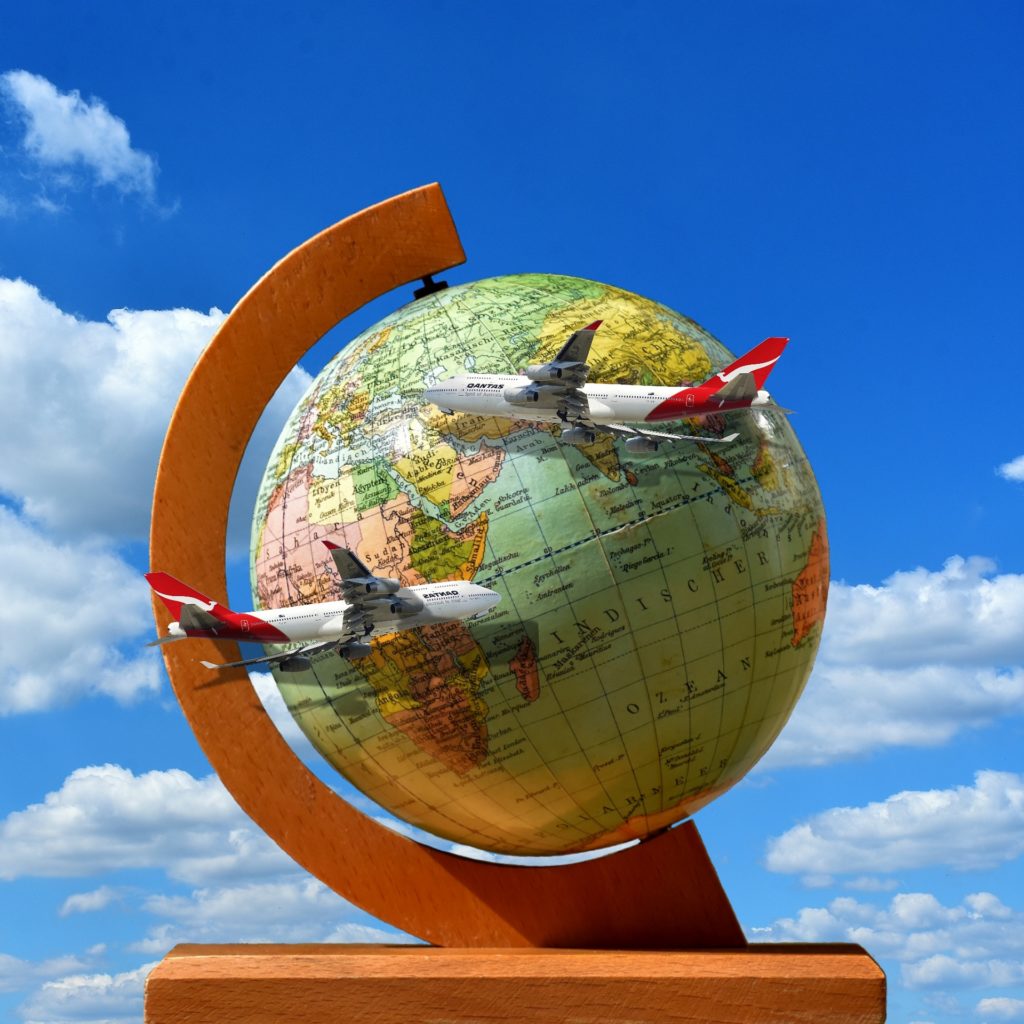
your ticket in one bulk RTW package, you can usually save yourself some money too — which is always a plus in my book. Keep in count that RTW tickets come with many rules and conditions that might not work for you. For example a RTW ticket is only valid for one year. So if you travel for more than a year, a RTW ticket is not a good option. Before buying a world ticket for your world trip, it’s best to inquire information at an (online) travel agency. There are, of course, countless websites for buying airline tickets on the internet, though only a handful offer a RTW ticket. The costs can vary from €1.250,- till €4.000 ,- or more, depending on your plans and how many stops you want to make.
One-way tickets
There is also the possibility to buy one-way tickets. On the internet you’ll read that it can give you more freedom in planning your world trip. This is partly correct. For your visa’s you’ll need to book 1-2 flights in advance to show the customs that you have proof that you’ll leave their country. But a big pro is that it gives you more freedom. You don’t have the whole trip already planned out.. so if you’re in Thailand and you’re considering to go to Bali instead of Malaysia, you’ll have the possibility to do so. A con is that if you’re going for one-way flight tickets it’s more difficult to get an accurate estimate of flight costs.

‘I choose for buying one-way tickets. I did this on the advice of a Dutch travel company called Kilroy which is specialized in long-term travel destinations. They advised me not to buy a RTW ticket because I’m traveling for more than a year and the RTW tickets are only valid for one year. So they recommended me to buy one-way tickets. They helped me with the bookings and to establish an estimated budget for all the airfare costs on my world trip. They came up with an estimated budget of €3.600,-. I was quite surprised that the costs were that low for a world trip with visiting 21 destinations and 7 continents. With this plan I’ll only book 1-2 flights in advance. If I’m entering Nepal and I want to book the next flight of my travel plan, I’ll give them a call. How great is that! The travel consultant knew exactly which flights were cheaper and which air flight routes are the best to take with my travel plans. I was glad that I booked my airfare at an organization which knows their stuff, instead of booking it by myself. In the long run I think I’ll save quite some money and I have the freedom to change my travel plans while on the way!’
My estimated costs: € 3.600,-
- Public transportation
Overland transportation costs
Chances are you will be traveling overland quite a bit during a world trip. It’s certainly cheaper than flying, and in countries like Bolivia and Laos, it’s practically free. But overland transport does add up after a while, particularly when taking 24+ hour bus and train rides. Remember that overnight travel negates the cost for accommodation, so that saves quite a bit of money right there. But it’s still important to factor in overland travel costs.
Airport transportation
Other transportation costs to consider is airport transportation. Most airports are located on the outskirts
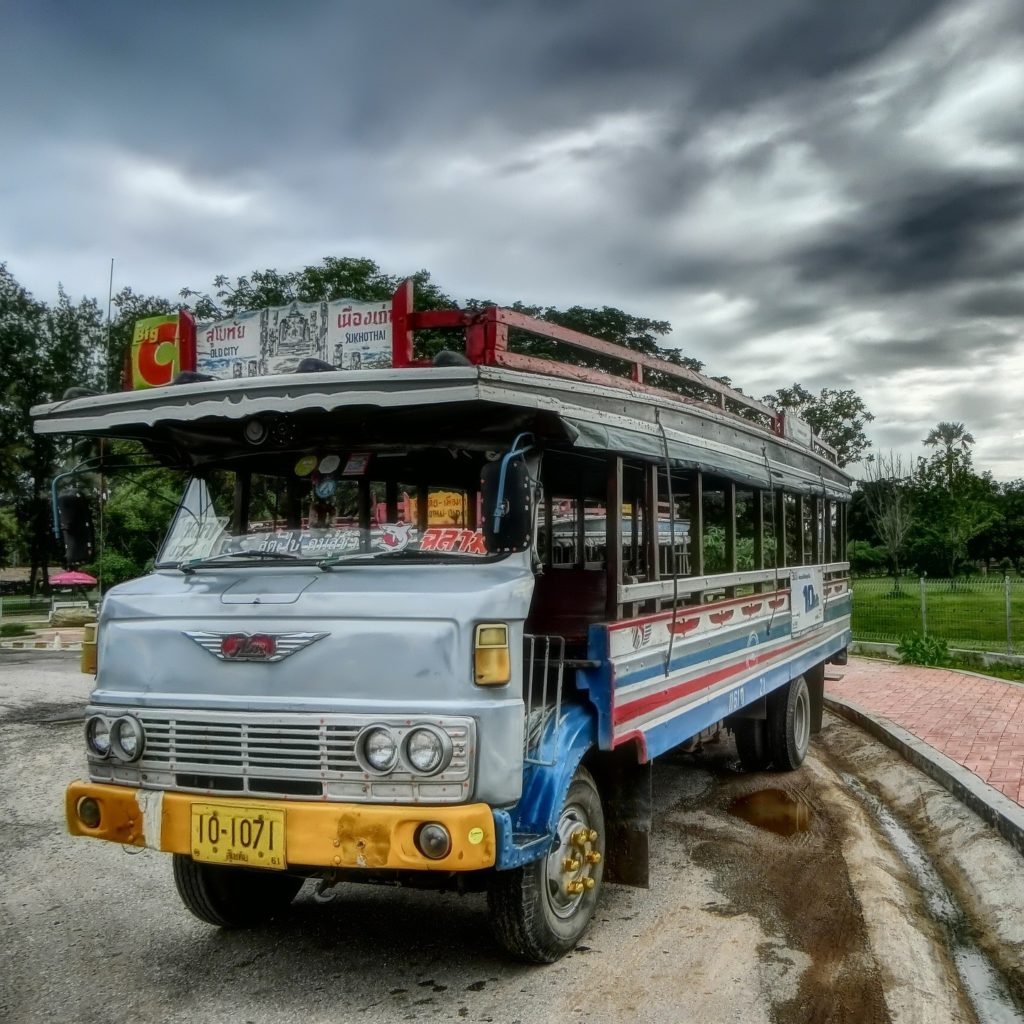
of cities, so getting into the city center is going to cost you. In larger cities it may actually be cheaper to get into town because they will most likely have some form of cheap public transport, but there’s a good possibility you’ll have to buckle up and take taxis in other places.
Local transportation
Walking is the preferred method of transport once you’re in a new city, but there are going to be times, particularly in larger cities, where you’re going to need more than your own two feet to get around. Busses, subways, tuk-tuks, rickshaws, and taxis all add up after a while, so keep this in mind when planning your budget.

‘To get an idea of the possible routes and costs for overland transportation I used the website of rome2rio (a great website!). Here you can plan a route by public or local transportation or planning overland trips. It also gives you an accurate cost estimate. Due to this website I made a good estimated of my transportations costs. I rounded up the costs of my estimated costs in case of changed plans or unforeseen matters.’
My estimated costs: € 5.660,-
- Daily costs
If you wish to travel for a certain length of time, estimate how much money you will have in total and then divide it by the number of days you plan on traveling. This will give you an idea of how much you can afford to spend each day. Then you can look for places that fit within that budget and balance out a few weeks in a more expensive place with some time in a cheaper destination. Finding these costs can be challenging and is one of the more frustrating parts of planning a trip of this magnitude. Guidebooks and other travel sites have per day costs for countries, but many are outdated by a few years and it also depends on how you travel (are you fine by hostel dorms or private rooms), so doing your research how they

came to that amount of daily cost can help you find out if it suits your travel style. If you follow any travel blogs, they are great resources for up to date information, but not all blogs talk about costs, and finding ones that do (and are also up to date) can take some time. You’re going to hear all types of budgets – from “I traveled the world on € 10 per day” to “Our family spent € 200,000 traveling the world” and everything in between. It’s important not to get caught up in this – do the legwork yourself and figure out the costs based on your situation.
- Accommodation
Everything you add on top of a hippie lifestyle is up to you. For example, a dorm bed in a hostel in Madrid might start around €15-20 per night (that same dorm room bed can costs around €5 in places like Latin America and Southeast Asia), but many people don’t like large dorm rooms full of strangers. If that’s you, you might be spending more like €40-50 in Europe (€15-30 in less expensive regions) for a private room.
It’s always a good idea to check out different hostel booking sites and start researching costs. This will give you the best idea of what you’ll be spending. Figure out what your minimum standards are and work from there. It’s always a good idea to add a little extra padding. Even if you are fine with camping or roughing it, after several days or weeks, you may want to splurge on a treat for yourself.
- Food costs
On the food side of things, it’s rather easy and often really enjoyable to get by on very little money, particularly if you’ll be staying in a lot of hostels, as they usually have a public kitchen where you can store and prepare your own food. Things like bread, cold cuts, pasta, and soup are always going to be cheap and easy to get. But is it really worth going to Madrid and not going to a few tapas bars for snacks and a couple beers? Be sure to budget for at least a few nicer meals in local restaurants.
If you plan on traveling in regions like Southeast Asia or the Middle East, street food is everywhere. Some travelers have strong opinions about street food, but it is typically amongst the best and most authentic food you’ll find in a place, and it’s dirt cheap. It would be a shame to miss out on it. Just be smart and use common sense. Visit stalls that are busy with high turnover and lots of locals. They know the good spots.

‘I based my daily costs on the information from the website: Globetrotterservice. I checked if these costs were still accurate, by comparing these costs with others blogs and costs of accommodation on www.booking.com, and it was quite correct. So I decided to use this source for my estimated daily costs. I want to travel as cheap as I can, so I took the lowest daily estimated costs. The daily estimated costs of this website include transport & activities. In my budget the daily costs are only for accommodation, food and laundry, so not including transport costs and entertainment. That’s why I took the lowest budget as an indication for my estimated budget. I think it suits my travel style well. I’m okay by dorm rooms and from time to time a private or unique room (for example a tree house in the jungle). I try to cook my own meals, eat street food and from time to time I’ll visit a restaurant. You can read my estimated budget per region for solo travelers, excluding entertainment and traffic costs, below!
Budget per day (accommodation, food and laundry)
Region | Daily costs |
Australia , New Zeeland | € 45 |
North America (U.S. & Canada) | € 45 |
South-America | € 25 |
Asia | € 20 |
West – Europe | € 45 |
East – Europe | € 30 |
Some of these regions like New Zealand and the United States are quite expensive. That’s why I want to grant my stay and look for a job (wwoofing or as an au pair) to lower these costs.’
My estimated costs: € 20.125,-
- Entertainment costs
Some of the best travel experiences are completely free – browsing the central market and getting lost in a city’s narrow streets. But it would be a shame to miss out on some potentially amazing experiences like viewing one of the world’s best museums or rafting down a pristine river because you don’t want to spend a few dollars to do it. In each location you plan to visit, think about the experiences you don’t want to miss, and be sure to budget enough money to cover them.
Don’t forget to budget for those really big expenses and activities that you’ve been looking forward to for years. While backpackers like to gain street cred for how little they spend, remember that you’re taking this trip of a
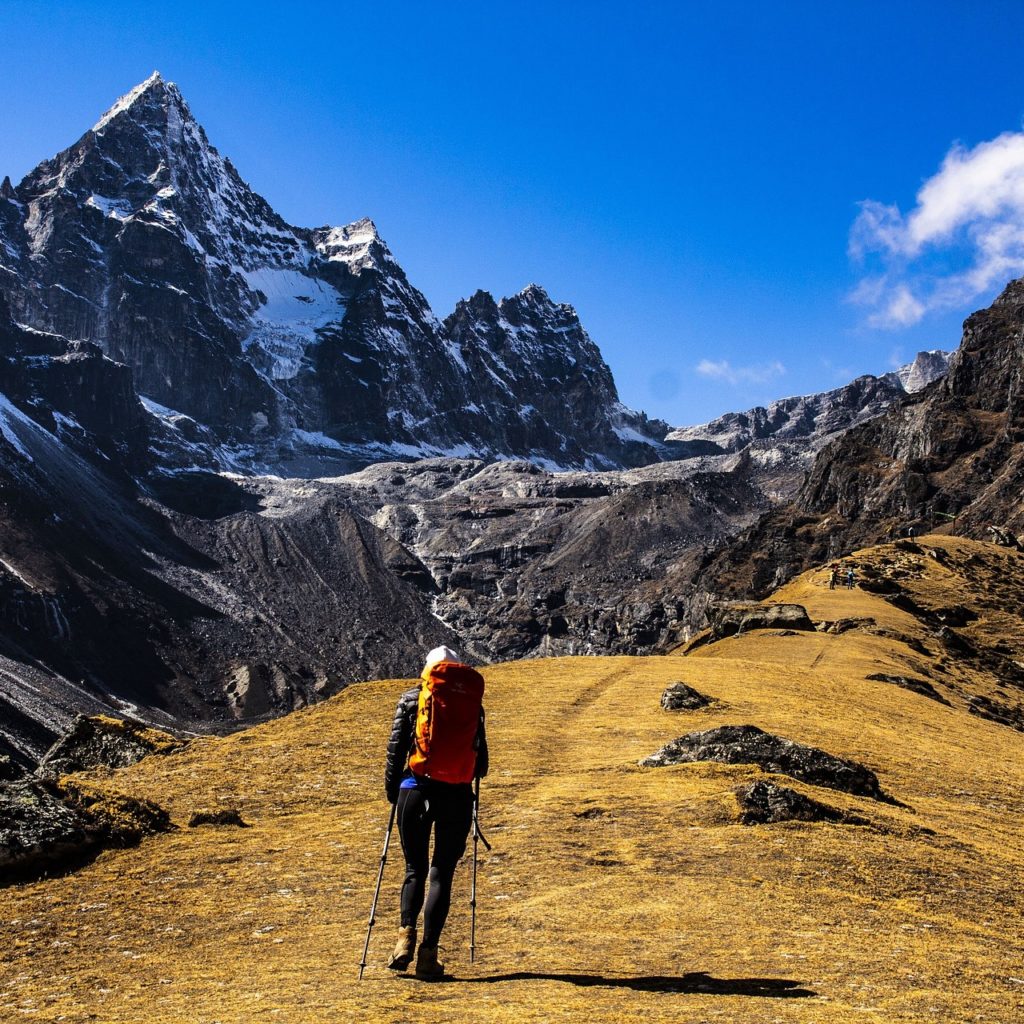
lifetime to do the things you’ve always dreamed about. Though hiking the classic Inca Trail will cost upwards of € 500,-, if it’s something you’ve wanted to do since you were a kid, not doing it because of high costs is just silly. Just remember to factor those large expenses into your budget now, well before you hit the road.
Often the difference in costs between travelers is mainly due to tourist activities, which are relatively expensive and put a strain on the budget. Think for example of boat trips, diving, excursions or renting a vehicle. That’s not to say you can’t do this sort of thing, but it’s something to keep in mind. So think in advance which things you want to do, and what impact that will have on your budget. Once you make that dream trip, you naturally want to be able to do a few things.

‘My trip is something I dreamed about for a long time and I want to enjoy it for 200% and get a full experience!! So I don’t want to skip out on activities like an amazing raft or hike the Mount Everest because it’s simply too expensive. I like outdoor and special activities, so the entertainment section of my budget is quite high. I rounded up the estimated costs more than probably necessary, so these costs may come out lower. In my estimated budget I have planned jungle treks in more than 10 countries, but probably I will get tired of this after 5 jungle treks. So I think (and secretly hope) my entertainment costs come down lower than I estimated.
My entertainments costs include trekking in the Mount Everest and Patagonia mountains, diving, visiting temples, cave-tours, jungle treks, boat trips, glacier kayaking and last but not least, my biggest expense: an expedition to Antarctica. And I can tell you one thing, these trips are not cheap!’
My estimated costs: € 19.150,-
Other expenses to consider
Transportation, accommodations, food, entertainment, and activities are all budget items that everyone knows of. But if you’ve never taken more than a couple of weeks vacation before, there are plenty of other expenses that you probably aren’t thinking about. And though many are small, they all add up, especially over the course of several months or a year. So while you may not have specific categories for these on your pre-trip budget spreadsheet, you need to keep them in mind and possibly add a few euros to your budget to cover them.
- Visa
Visas are something you should research long before leaving. Some you can take care of before leaving home, some you will have to purchase on the road. You will be shocked at the amount of money some countries charge for entrance. These can add up quickly. Want to know more about visas? Click on the link below to read my post about researching your visas.
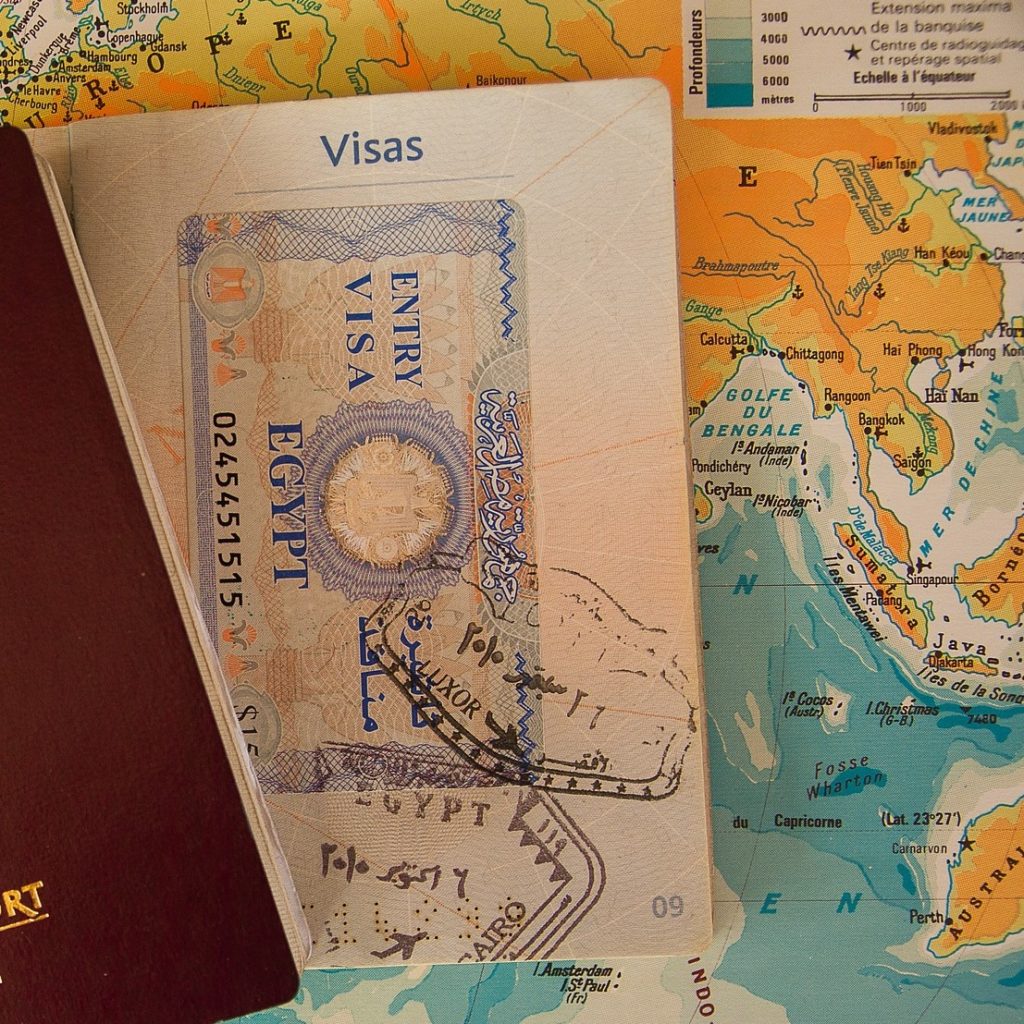

Some countries don’t ask to get a visa for the first 90 days till 6 months (most of the countries in South- and Central America). But others will, and these costs can be quite expensive. For example, I was shocked to find out that a 30-day tourist visa in China will cost you more than 100 euro.
My estimated costs: 500,-
- Gear
You may have to purchase a backpack, which is no small expense and one that you really don’t want to go cheap on. Your back will thank you a few weeks into your trip. Travel specific clothing, while not necessary, can be really nice, but it can also be really expensive. It’s not too difficult to spend $500-$1000 on pre-trip gear. Keep in mind that people wear clothes all over the world, and you will purchase clothes as you go, so there’s no need to buy and pack for every single contingency.
Want to know more about buying gear? Click on the link below to read my post about gear and packing.
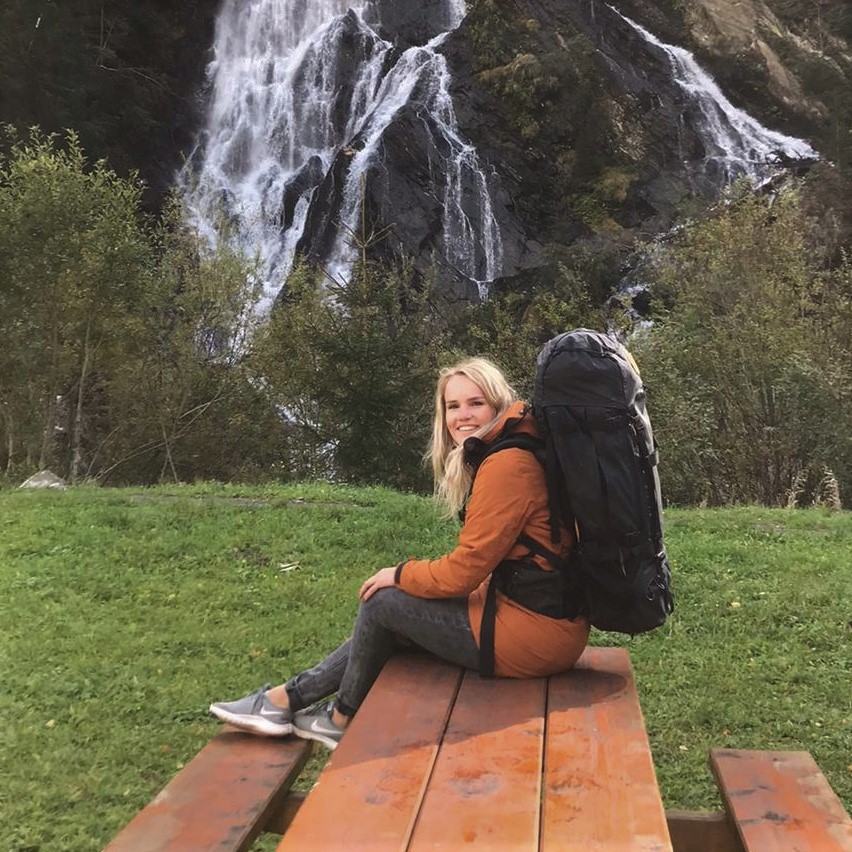

Well, first of all I don’t have a cheap taste and all my stuff has to match with one another. So my estimated costs are a bit higher than average I guess…But besides my backpack and clothing, I need to have a laptop and camera as well. That’s the main reason why my estimated costs turned out a bit higher.
My estimated costs: € 2.500,-
- Insurance
Insurance of any kind is never a fun, but rather a frustrating subject to research. But unfortunately it’s a necessity, especially if you’re going on a long term trip. What if you break your leg while hiking in the mountains and you need to go to the hospital by helicopter. Well…that can cost over more than 10.000 euro. Do you want to take that risk? Many people never bother with travel insurance, and other people would never travel without it. Most of this has to do with your own personal situation, who you’re traveling with, comfort level, and risk-taking ability.
Most backpackers (like me) are on a budget, so they must decide which policies are worth the money and how much risk they are willing to take. Some only get a policy that has emergency medical service for worst case scenarios. Some want to add trip protection in case of any unforeseen problems with things like flights and lost luggage. Travel has risks, and everyone has their own opinions on how much risk they are willing to take. It’s important to educate yourself before making your decision and look into all your options, no matter if you’re going on a one week backpacking trip or a multi-year round the world adventure.
Want to know more about travel insurance? Click on the link below to read my post.

‘This was a difficult subject, because there was a lot of different information on the internet if you have coverage abroad from health care insurance in the Netherlands or not, and whether I’m obligated to hold on to my insurance or not. Because you can get a fee if you don’t have a health care insurance. So after some research I found out that if you travel abroad whether you’re a registered citizen at the municipal or not you’re obligated to have a Dutch health care insurance. There is the exception that if you work abroad you won’t have coverage and therefore you’re not obligated to have a Dutch health care insurance. That’s a pro for me, because health care insurance in the Netherlands is quite expensive and with a good travel insurance I have a good health care coverage too. Health care insurance is around 125 euro each month and I need to have a travel insurance beside that as well. That will cost me approximately 150-180 euro per month. While a good travel insurance with health care coverage will cost me approximately 40 euro per month. That saves me a lot of money!’
My estimated costs: € 1.300,-
- Immunizations
Vaccinations are expensive. There’s no way around it. Deciding on what’s necessary or not is totally up to each individual, but some vaccinations are non-negotiable. Many countries won’t even let you in without proof of certain vaccinations, especially after the COVID-19 pandemic. Make sure you do your homework and get the right ones, and shop around because costs vary dramatically.
Want to know more about vaccinations? Click on the link below to read my post.
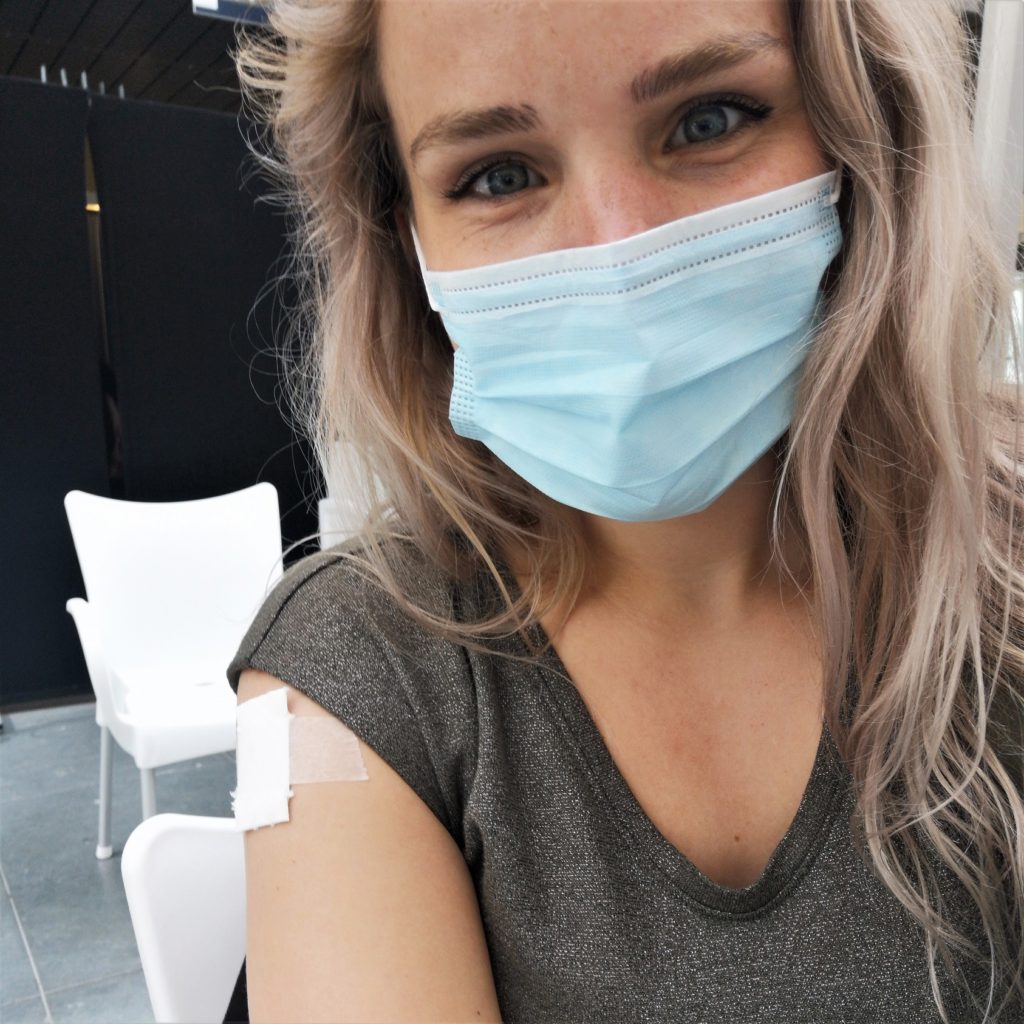

Lucky for me I’m a healthcare professional, so I already got all my hepatitis-B vaccination shots (this is obligated if you want to work in healthcare, with the advantage that it’s paid for you) that saved me 150 euro and with a previous holiday I already got my hepatitis A vaccination shots as well. That saved me another 120 euro. I wanted to have all the vaccination shots professionals advised me to have. I consulted the local health service, called the GGD, for advice about the vaccines and malaria precautions. I needed the Rabies, yellow fever, typhoid and Diphtheria Tetanus Polio (DTP) vaccine. This cost me in total (vaccines + consult costs) 350 euro.
My costs: € 350,-
- Data
Many hostels and hotels offer free wi-fi these days, but not all. And if you’re not traveling with a laptop, phone, or tablet, then you will have to spend some time in internet cafes. While most countries don’t charge a ton, there are others that charge a ludicrous amount for using the internet. Be sure to factor this into your budget.
A lot of travelers buy SIM cards. Buying a sim card allows your phone to connect to the local network, and thus the internet. Using the SIM card from a previous country means you’ll be roaming internationally and paying a lot more. This is a big loss of money! A local SIM card is the cheapest option for almost every digital nomad out there


I chose a data-only SIM card, because I don’t call often or send messages to people. I usually use WhatsApp, Facebook or Instagram to stay in contact with others. I found an explanation about Sim cards and traveling on an article from Chris at worthygo. Still it was difficult to get an average estimated amount of costs for each month or SIM card. After comparing some information I think I got a good guess of the costs: 10-15 euro for 2 GB of data. With me traveling for more than 24 months the cost will be around 350 euro.
My estimated costs: € 350,-
My estimated budget
To get an idea of all the estimated costs and what my budget will be I made an overview. You can see my estimated budget below:
Airplane costs
€ 3.600,-
Public transportation costs
€ 5.660,-
Daily costs
€ 20.125,-
Entertainment costs
€ 19.150,-
Visa costs
€ 500,-
Gear costs
€ 2.500,-
Insurance costs
€ 1.300,-
Vaccination costs
€ 350,-
Data costs
€ 350,-
Total costs
50.835,-
- saving Money!
Now that you have a general idea of what your trip may cost, you may start to freak out a bit (well…I did!), but don’t worry! The next step will be figuring out how much you can save per month. I read a great article from Nomadic Matt that I’d like to share with you. Click on the button to go to the article.

TravelSpend
To manage my finances along the way I’ll keep track of my spendings on the app: TravelSpend. I know myself, I know that I can start very enthusiastic with spending money on activities, souvenirs and good food. But I must stay within my budget! Otherwise I need to skip some countries because I’m already out of money. Besides managing my own finances I want to keep track of my expenses to help & inform others in planning their world trip. TravelSpend is a great tool to achieve these goals, because:
- It helps making it easy for me to add expenses on the app while on the go. Adding new entries in TravelSpend is quick and easy. It works offline and foreign currencies are automatically converted.
- It helps me to stay put on my budget. It keeps track of my travel budget and all my expenses. This will help me cut costs and save money.
- It helps me to gain insight of my spendings. My spending data is visualized. I can analyze my expenses and avoid overspending. Some places are naturally more expensive or cheaper than other, and with this app it’s easier to view the differences.
To see how much the actual costs of my world trip is, you’ll need to wait at least two years to find out. In two years I’ll be back from my world trip and then I’ll have all the numbers – received throughout this app – that, of course, I’ll share with you!

